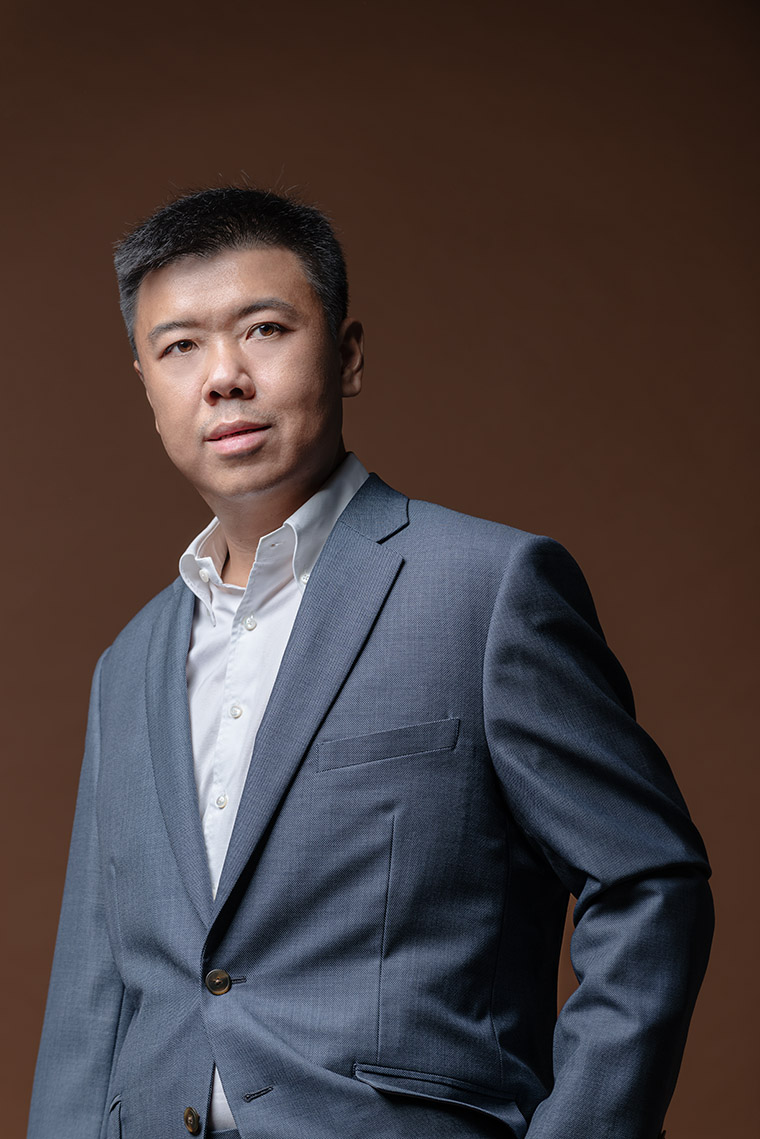Kelvin Lim admits to me that he was somewhat relieved to hear about Singapore going into heightened alert even for a limited time. With new restrictions that reinstated working from home as the default mode, and reduced social gathering participants to just two from the previous five, he hoped that things would slow down a bit. “I’ll finally be able to spend some time alone and do some reflection,” he says, an activity that didn’t fit in his packed social and work calendars.

At LHN Limited, a group of companies in property leasing, logistics services, and facilities management businesses, Lim does wear many hats: he is the executive chairman, executive director, and group managing director, responsible for business development and overall management, including investment activities, operations, and marketing efforts of the Group. Despite teams of professionals providing him with support, Lim, 44, is still expected to make the final call, and this is where the reflection bit comes in: Lim likes to constantly evolve new business concepts. These days he is thinking a lot about their self-storage business and how it can be elevated with value added service.
The e-commerce surge has raised the demand for storage facilities, but while e-retailers manage bulk orders efficiently in small offices their sizable merchandise still has to be handled and stored properly. “Besides storage space and management, we also provide our customers with a set-up within our facilities where they can do some paperwork, as well as last-mile delivery service,” he says. “I think most of them can now use a showroom to display their merchandise. Offices are having a hard time staying open, maybe some of them can be converted into display facilities,” he shares with recognizable enthusiasm.
- AN EARLY START
- INTEGRATED AND RATIONALIZED
- BUOYED BY DEMAND
- OPTIMIZING SPACES
- THE WAY FORWARD
An Early Start
Lim joined the family business in 2001 when his father was starting to rent out industrial space. The new venture was an offshoot of the family’s timber trading and sawmill businesses which by then had already waned. As their timber factory was converted into a warehouse, the family business gradually transitioned into property leasing. Lim was just 20 years old at the time. “I had not finished school (at Singapore Polytechnic) yet, but I was eager to go into business,” he recalls. His father did not oppose his decision. “He was actually supportive,” Lim says, “but he did not specifically ask me to join him; I was the one who showed interest.”
But the young Lim also saw other opportunities elsewhere, so that while his father ran the leasing business, he began pooling spaces to sub-lease. He entered into master lease agreements with a few landlords, repurposed the properties, and offered them to tenants. This allowed him to grow the business without the enormous capital outlay associated with property acquisition. It also gave him the ideal speed to jump into sectors that were ripe with opportunities.
In 2015, with Lim at the helm, the Group went public through an IPO. (LHN is listed on both the Catalist board of SGX-ST and the main board of the HKSE.) The exercise raised close to S$20 million, allowing the Group to realize its goals of elevating its corporate profile, bringing in more professionals, and expanding into foreign market. “Today, we are considered as an asset-light company,” Lim points out. “We are managing about 40 properties but we own less than 20 per cent of them. Most of the properties are still on master lease, and the beauty of it is we can offload them – return them to the landlord, when they have stopped doing well.”
- AN EARLY START
- INTEGRATED AND RATIONALIZED
- BUOYED BY DEMAND
- OPTIMIZING SPACES
- THE WAY FORWARD
Integrated and Rationalized
LHN Group runs an integrated array of businesses where one entity supports the efficiency of another, which in turn derives value from yet another. This is perhaps among Lim’s most important contributions to the early days of the company, and one that rationalizes the activities of the different businesses until today – that all activities contribute to the greater good. “I understood early that in any kind of business, diversification and adaptation are important for a sustainable growth,” he explains, “especially in a fast-changing environment like Singapore. We cannot just focus on one industry; if we do, our growth will be limited.”
When I point out that the logistics business does not seem aligned with either property leasing or facilities management, Lim counters that it developed organically from within the company. “We’ve been doing logistics services for 20 years. In the beginning, we had a lot of industrial spaces, but rather than sub-leasing all of them to end-users, we used some for logistics services to add value to the space.” He has thus successfully evolved the company’s business from traditional space leasing to real estate management supported by facilities management and logistics services.
Over the years, they have grown a container depot (HLA) and a transportation business (LHN Logistics), which have been instrumental in establishing a foothold in Southeast Asian markets. For instance, LHN Logistics’ container depot business is in Singapore, Thailand and Myanmar, while the transportation service, with its modern fleet of prime movers, trailers, tankers, etc., delivers industrial chemicals and dangerous goods across the border to Malaysia. “With the growth of the ASEAN transport route, we can transport goods anywhere in the region by land. That will expand our footprint considerably,” he says.

- AN EARLY START
- INTEGRATED AND RATIONALIZED
- BUOYED BY DEMAND
- OPTIMIZING SPACES
- THE WAY FORWARD
Buoyed by Demand
The current demand for co-living and self-storage spaces is very stable, providing fuel for the Group’s space optimization business. Lim foresees continued growth in the demand for mixed-use developments this year alongside very positive market response to the ‘live-work-play’ concept. As of third quarter 2019, privately owned co-working operators accounted for almost 37 per cent of market share versus 44 per cent of privately-owned serviced office operators, Lim says, citing a CBRE report. By 2030, at least three out of five buildings will have a flexible office component.
“People are found to be happier living in neighborhoods that provide for most of their needs, and enjoy the ease of living near their workplaces, amenities and recreational spots.” The same sentiments hold among e-commerce retailers who may want to work where they live. “(For now) they could be renting a co-working space within the CBD and storing their goods in Jurong, but combining both in a single location will help them save time and business (transportation) cost, and become more efficient.”
Meanwhile, the global market size of co-living industry has reached about US$7.9 billion, according to thehousemonk.com, of which Southeast Asia accounts for US$54 million. Southeast Asia saw 20 per cent more co-living facilities tenants in 2020 than in 2019. “The sharing economy is definitely here to stay,” Lim says. “It is an extremely attractive concept for value-conscious consumers as they can enjoy greater savings with the same lifestyle. Additionally, as more Singaporean consumers pay attention to their carbon footprint, the sharing economy will continue to grow as an attractive alternative to ownership.”
- AN EARLY START
- INTEGRATED AND RATIONALIZED
- BUOYED BY DEMAND
- OPTIMIZING SPACES
- THE WAY FORWARD
Optimizing Spaces
Facilities management has been the leading contributor to Group’s profitability for the past two years, Lim reveals. This is followed by logistics and then by space optimization. “Growing a new concept takes a long time,” he concedes. “Space optimization used to be our most profitable (business); over the past two or three years, we have been aggressively growing our self-storage and co-living businesses. At the same time, we have been relinquishing spaces that are losing relevance in the current market.” Last year, the Group returned 1 million sqft of space to a landlord in Tuas; the space was allocated to the oil and marine industries which have not been performing well of late.
As a major business entity for the Group, space optimization is one with ample room for expansion. “We select an existing building that fits our purpose, we retrofit the space, and then rent them out. It is fast and efficient,” Lim underscores. There is enough supply of buildings that can be repurposed under the en bloc redevelopment scheme, he says, which will ensure the sustainability of the business in the coming years. “We happen to own car parks in Golden Mile Tower and Bukit Timah Shopping Centre. These buildings are about 30 to 40 years old and have strong redevelopment potential. There are also shophouses all over Singapore that can be redeveloped and repurposed within conservation guidelines.”
Within the Group is a dedicated project management department for the space optimization business. It manages the conceptualization, design, call for tender, and awarding of projects to independent contractors. Once a project has been completed, it is handed over to the in-house operations department to run. Lim, however, is only interested in delivering quality projects – for two reasons: firstly, it prevents them from descending into a price war with other operators, which he finds tedious and unproductive, and secondly, it fulfils the Group’s green agenda. Currently, close to 10 per cent of open land areas within their properties are landscaped, but they plan to increase the green coverage within their properties by another 5 per cent.
- AN EARLY START
- INTEGRATED AND RATIONALIZED
- BUOYED BY DEMAND
- OPTIMIZING SPACES
- THE WAY FORWARD
The Way Forward
“My vision is for us to be a $500 million market cap company by the end of this decade,” Lim declares. “I want us to have a footprint that spans beyond Singapore – to across the region and Greater China, providing customers with ideal space solutions,” he continues.
To realize his vision, Lim is focusing on growing the Group’s space optimization business through industrial and commercial factory leasing, co-living apartments, co-working spaces, logistics services and self-storage, and integrated facilities management services. The demand for such spaces has been going up since the beginning of the pandemic and the consequent shrinking of office spaces occupied by large companies.
“Our lean and agile corporate structure gives us the advantage to try new things, fail fast, learn fast, and move forward,” Lim elaborates. “That’s why we have constantly explored new areas and kept ourselves ahead of the curve.” The pandemic has given rise to business innovation in all sectors, and for LHN this is linked to the way people rethink how they want to live, work, and play. This opens up tremendous opportunities for growth. Needless to say, given their flourishing business in space optimization, they are in a sweet spot.












 Back
Back
